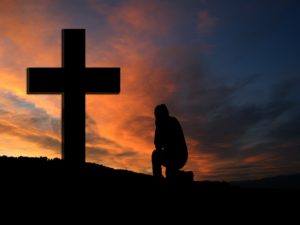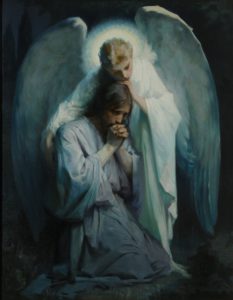Some deceptions are so obvious as to be audacious, like the Jehovah’s Witness teaching that Jesus returned invisibly in 1914 when he failed to turn up physically, as predicted. Or the Mormon claim that Jesus walked the Americas following his resurrection and spoke to a boy in a grove of trees in 1820. Others are so subtle as to pass you by if you don’t know what you are seeing, what you are hearing.
The March 2015 Ensign magazine of the Mormon Church, as you might expect, anticipates Easter, and the momentous events of that first Easter, as will Christian publications around the world. Well, not quite as will Christian publications.
The Christian Easter
The focus of every Christian on Good Friday is Golgotha, the place where Jesus bore the penalty for the sins of the world, suffered crucifixion, and died. The events surrounding that defining sacrifice are also in mind of course.
The Last Supper, at which the new covenant was inaugurated; the servant king washing the disciple’s feet; the high priestly prayer prior to going out into the night; the charge to the disciples to watch and pray, and their failure to watch one hour; the struggle to face the impending suffering and the heart-rending petition, ‘If it be possible, let this cup pass’.
The supreme act of submission, ‘yet not my will, but yours’; the extreme anguish that produced hematidrosis, where the capillary blood vessels burst in extremis, causing him to, ‘sweat, as it were, great drops of blood’; the comforting presence of a messenger of God, an angel to strengthen him; the affectionate betrayal by Judas; the brutality of the guard; the desertion of his friends; the mocking trial; the scourging, and the cries of, ‘Crucify!’
The final cry, ‘It is finished,’ tetelestai, paid in full; the taking down of his lifeless body; the petition of Joseph of Arimathea to Pilate to be allowed to bury the Lord; the hurried preparation of the corpse; the hasty burial, and the inconsolable grief of his family and followers.
Yet much of this would have been the experience of so many unfortunate men. The summary justice, the brutal treatment, the baying crowd, even sweating blood in the extremity of anguish is not an unknown phenomenon in history. What set this God/man apart was what happened on the cross of Calvary. The pivotal point of this drama is Golgotha, the crucifixion, where Jesus bore the penalty for the sins of the world. The blood of Calvary has a sacred significance for Christians.
In the Old Testament we read about animal sacrifices to God, part of the animal eaten by God’s people signifying their close fellowship with God. The drinking of blood, however, was strictly forbidden. The blood signified life. In Leviticus we read, ‘the life of the creature is in the blood.’ (Lev.17:11) The blood was not drunk but was poured on the altar to remind God’s people of the price of their fellowship with God (Lev.3&7).
When God delivered Israel from slavery in Egypt the angel of death is said to have passed over the houses of the Israelites who had smeared their door posts and lintels with the blood of a lamb. That is where the festival of Passover comes from. Passover, that time when the Lamb of God sacrificed himself, shed his blood, for our sins.
Blood signifies a life sacrificed and means the same as the word death, as when we speak of ‘bloodshed.’ Whenever, in the New Testament, we read about the blood of Jesus we should always understand it to mean his death.
The New Testament tells us that, ‘in him [Jesus] all the fullness of God was pleased to dwell, and through him to reconcile to himself all things, whether on earth or in heaven, making peace by the blood [death] of his cross.’ (Col.1:19-20, ESV) It is the blood of the cross that reconciles.
The apostle John reminds us that, ‘the blood [death] of Jesus cleanses us from all sin.’ (1 Jn.1:7, ESV)
In Revelation we read about, ‘Jesus Christ…who loves us and has freed us from our sins by his blood [death]…’ (Rev.1:5)
Peter writes, ‘you were ransomed from the futile ways inherited from your forefathers, not with perishable things such as silver and gold, but with the precious blood [death] of Christ, like that of a lamb without blemish or spot,’ (1 Peter 1:18-19)
The analogy of a sacrificial lamb couldn’t be clearer. We are ransomed from our sinful lives by the shed blood (death) of Christ, ‘a lamb without blemish or spot.’
‘In him we have redemption through his blood [death], the forgiveness of our trespasses,’ writes Paul in Ephesians 1:7, and again in Romans 5:9, ‘we have been justified by his blood [death]…’
I reiterate, whenever, in the New Testament, we read about the blood of Jesus we should always understand it to mean his death and the Scripture makes that clear.
 The Message of the Cross is the power of God to those being saved (1 Cor.1:18)
The Message of the Cross is the power of God to those being saved (1 Cor.1:18)
Christians were, and still are, persecuted for the cross of Christ (Gal.6:12)
Paul boasted in nothing but the cross of Christ (Gal.6:14)
Enemies of Christ are enemies of the cross (Philip.2:18)
Our record of debt because of sin is cancelled by being nailed to the cross (Col.2:14) and Jesus triumphed on the cross (Col.2:15)
The Mormon Easter
Yet there have always been, and still are, those who consider the message of the cross foolish (1 Cor.1:18) It is a stumbling block to them (1 Cor.1:23) and of such it appears are the Mormons. In their ‘modern revelation’ they empty the cross of its power into the Garden of Gethsemane.
In one of his earliest ‘revelations’ Joseph Smith redefined the atonement of Jesus:
‘But if they would not repent they must suffer even as I; Which suffering caused myself, even God, the greatest of all, to tremble because of the pain, and to bleed at every pore, and to suffer both body and spirit.’ (Doctrine & Covenants (D&C) 19:17-18)
Mormon Church president Joseph Fielding Smith said of this passage, ‘We get into the habit of thinking, I suppose, that his great suffering was when he was nailed to the cross by his hands and his feet and was left there to suffer until he died. As excruciating as that was, that was not the greatest suffering he had to undergo…so great was his suffering before he ever went to the cross…blood oozed from the pores of his body.’ (D&C Institute Student Manual, 1981, p.38)
The problem Mormons have with this section of the D&C is its description by Joseph Fielding Smith as, ‘one of the great revelations given in this dispensation; there are few of greater importance than this.’ (ibid) It is difficult, then, for Mormons to get around Gethsemane and back to Golgotha and it has always been a controversial teaching.
Mormon apostle Bruce R. McConkie wrote, “As He came out of the Garden, delivering himself voluntarily into the hands of wicked men, the victory had been won. There remained yet the shame and the pain of his arrest, his trials, and his cross. But all these were overshadowed by the agonies and sufferings in Gethsemane. It was on the cross that he ‘suffered death in the flesh’, even as many have suffered agonising deaths, but it was in Gethsemane that ‘he suffered the pain of all men, that all men might repent and come to him.'”
(The Mortal Messiah, McConkie, pp 127-28)
The Mormon apostle Jeffery R Holland, speaking from the Mount of Olives, declared, ‘It was here in the Garden of Gethsemane. on that last night of mortality, that Jesus left His Apostles and descended alone into the depth of agony that would be his atoning sacrifice for the sins of the world.’
(Ensign, April 2002, p.14)
Thirteenth Mormon president, Ezra Taft Benson, in the same edition, ‘It was in Gethsemane that Jesus took on himself the sins of the world, in Gethsemane that His pain was equivalent to the cumulative burden of all men, in Gethsemane that he descended below all things so that all could repent and come to Him.’ (Ensign, 2002, p.14)
So again the first presidency message, by Deiter F. Uchtdorf, concentrates entirely on the garden, even down to an illustration of Jesus being comforted by an angel. There is no cross in this Easter edition of the Ensign. Quoting D&C 19, he illustrates his understanding of Christ’s redeeming sacrifice with a painting by the Danish artist Frans Schwartz, The Agony of Gethsemane (right).
In the centre pages there is a pictorial retrospective of where Jesus lived and walked. The Jordan River; the temple; Temple Mount; an ancient olive tree; a possible site of the Garden Tomb, and Golgotha, but no cross.
In a later article, Russell M Nelson writes about ‘the unspeakable agony in the Garden of Gethsemane and on the cross,’ yet the text he comes back to is D&C 19.
But it is the cross not the garden – oh, yes, the cross, not the garden. If they could but grasp the significance of the cross, the total loss and abandonment he suffered, the weight he bore, ‘My God, my God, why have you forsaken me?’ Not the comforted and strengthened Jesus of the garden (Lk.22:43) but the abandoned and desolate Saviour of the cross.
Not the garden where, in exquisite anguish, he anticipated his sacrifice in intimate association with heaven, but the cross where heaven looked away for the sin he bore. As far away as a person is from the cross, so far they are from Christ (Gal.6:14)
In March of 2014 I was visiting the small Maltese island of Gozo with friends. We went into a church in the capital, Victoria, and being Roman Catholic it had statuary depicting the Easter events that were soon to be extravagantly marked. I called my friends over and we sat as I used the imagery to explain to them why I finally left Mormonism and became a disciple of Jesus Christ. I told them about the Mormon view of Gethsemane and of how the wisdom of the cross finally broke through to me, showing me that my hope was found in the God/man who suffered for my sins as he hung there and died, and in the miracle of the empty tomb.
I could never go back to the Garden.

